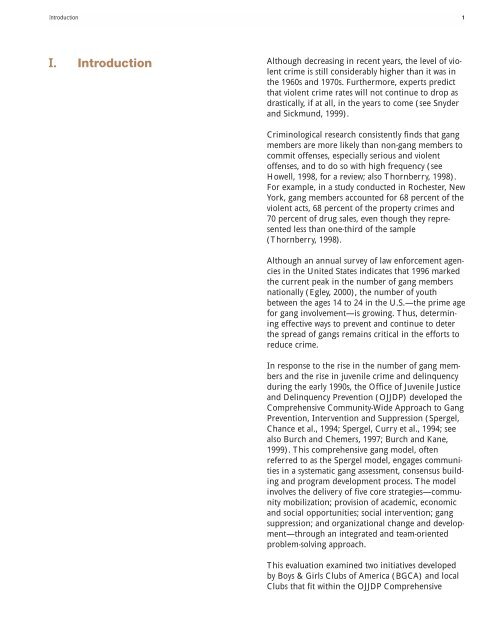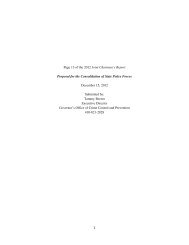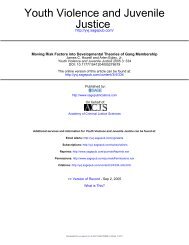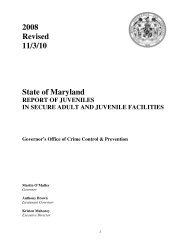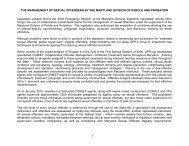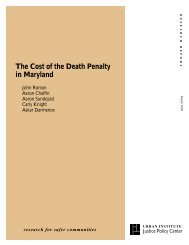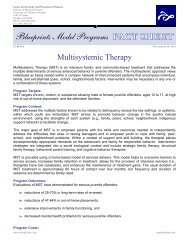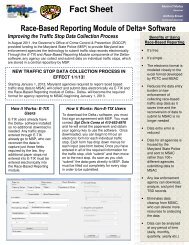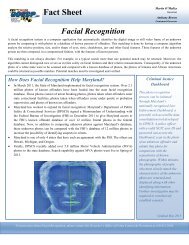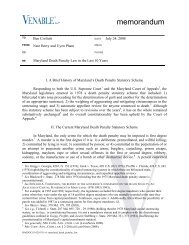Targeted Outreach - Governor's Office of Crime Control & Prevention ...
Targeted Outreach - Governor's Office of Crime Control & Prevention ...
Targeted Outreach - Governor's Office of Crime Control & Prevention ...
Create successful ePaper yourself
Turn your PDF publications into a flip-book with our unique Google optimized e-Paper software.
Introduction 1<br />
I. Introduction Although decreasing in recent years, the level <strong>of</strong> violent<br />
crime is still considerably higher than it was in<br />
the 1960s and 1970s. Furthermore, experts predict<br />
that violent crime rates will not continue to drop as<br />
drastically, if at all, in the years to come (see Snyder<br />
and Sickmund, 1999).<br />
Criminological research consistently finds that gang<br />
members are more likely than non-gang members to<br />
commit <strong>of</strong>fenses, especially serious and violent<br />
<strong>of</strong>fenses, and to do so with high frequency (see<br />
Howell, 1998, for a review; also Thornberry, 1998).<br />
For example, in a study conducted in Rochester, New<br />
York, gang members accounted for 68 percent <strong>of</strong> the<br />
violent acts, 68 percent <strong>of</strong> the property crimes and<br />
70 percent <strong>of</strong> drug sales, even though they represented<br />
less than one-third <strong>of</strong> the sample<br />
(Thornberry, 1998).<br />
Although an annual survey <strong>of</strong> law enforcement agencies<br />
in the United States indicates that 1996 marked<br />
the current peak in the number <strong>of</strong> gang members<br />
nationally (Egley, 2000), the number <strong>of</strong> youth<br />
between the ages 14 to 24 in the U.S.—the prime age<br />
for gang involvement—is growing. Thus, determining<br />
effective ways to prevent and continue to deter<br />
the spread <strong>of</strong> gangs remains critical in the efforts to<br />
reduce crime.<br />
In response to the rise in the number <strong>of</strong> gang members<br />
and the rise in juvenile crime and delinquency<br />
during the early 1990s, the <strong>Office</strong> <strong>of</strong> Juvenile Justice<br />
and Delinquency <strong>Prevention</strong> (OJJDP) developed the<br />
Comprehensive Community-Wide Approach to Gang<br />
<strong>Prevention</strong>, Intervention and Suppression (Spergel,<br />
Chance et al., 1994; Spergel, Curry et al., 1994; see<br />
also Burch and Chemers, 1997; Burch and Kane,<br />
1999). This comprehensive gang model, <strong>of</strong>ten<br />
referred to as the Spergel model, engages communities<br />
in a systematic gang assessment, consensus building<br />
and program development process. The model<br />
involves the delivery <strong>of</strong> five core strategies—community<br />
mobilization; provision <strong>of</strong> academic, economic<br />
and social opportunities; social intervention; gang<br />
suppression; and organizational change and development—through<br />
an integrated and team-oriented<br />
problem-solving approach.<br />
This evaluation examined two initiatives developed<br />
by Boys & Girls Clubs <strong>of</strong> America (BGCA) and local<br />
Clubs that fit within the OJJDP Comprehensive


